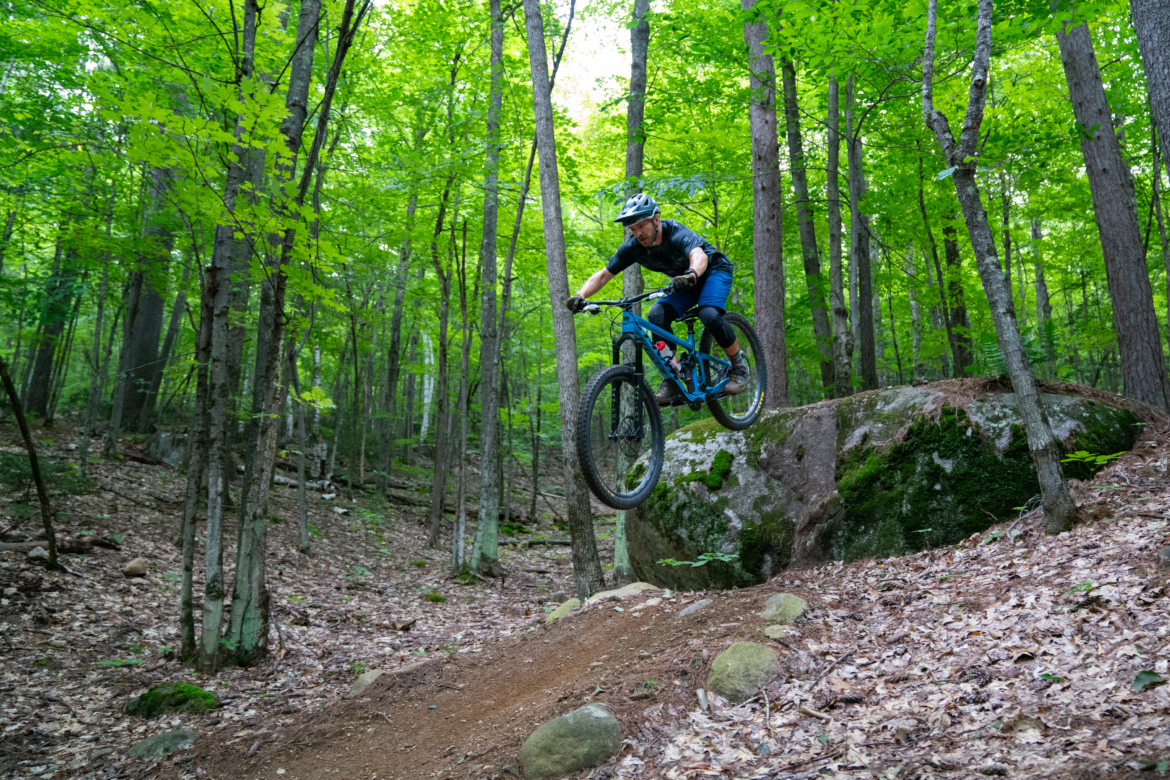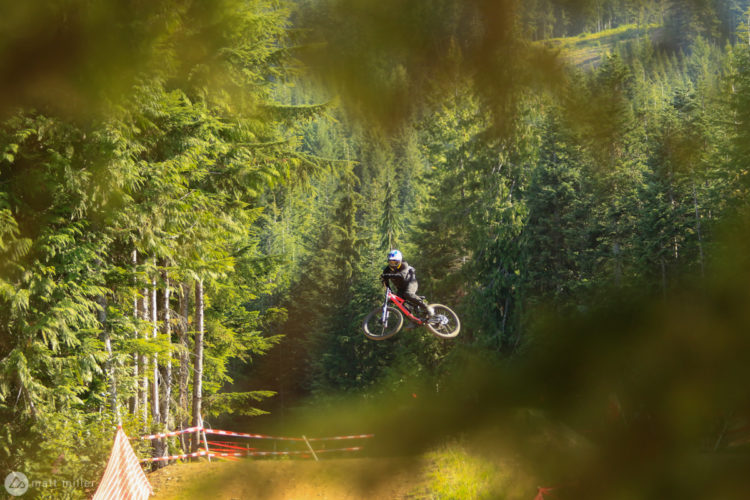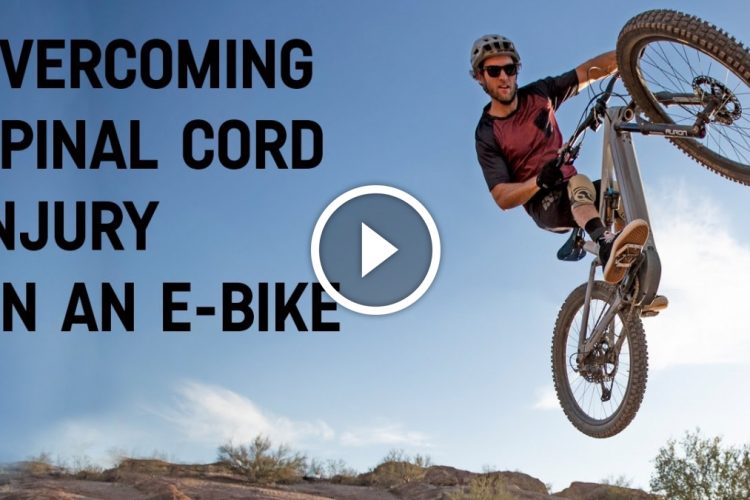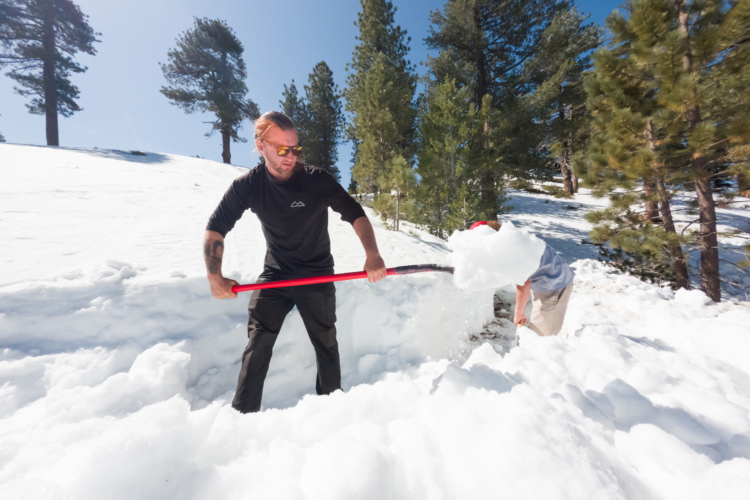
As a full-time mountain biker and part-time rock climber, whenever I chat with a diehard climber over a drink, they inevitably drop the longstanding joke, “The only time a rock climber gets injured is when they’re mountain biking.”
It’s funny because rock climbing is considered by the general public to be an insanely dangerous sport. But when you actually get into the sport and realize how robust and overbuilt the safety gear is, you learn that, with basic training, you can climb vertical cliff faces with little fear of injury.
Unfortunately, the same thing can’t be said for mountain biking. Whipping down narrow trails filled with rocks and roots at high rates of speed, often framed by a sheer drop-off on one side, is a recipe for an inevitable disaster. Even if we don’t think we’re taking unnecessary risks, freak accidents inevitably happen, dashing us to the ground.
While riders do occasionally die in crashes, mountain biking still isn’t as deadly as backcountry skiing or mountaineering. Normally, when things go wrong, you don’t die — but it’s awfully easy to get injured.

My own injury story
Tearing my ACL was one of the worst injuries that I’ve had in my life, requiring not one but two surgeries over the course of two years to finally fix it. But that happened while downhill skiing, not mountain biking. While mountain biking, I’ve suffered numerous smaller injuries, including:
- Concussions, including one ambulance ride to the ER.
- Back injury, causing daily pain for over 9 months.
- Nerve damage, which prompted a doctor to say, “Maybe you should take up surfing instead.”
- Numerous sprains, including both ankles, wrists, many fingers, and probably more.
- Torn ligaments in both ankles.
- Partially torn rotator cuff.
- Hip injury, including torn labrum, which I was told I’d need surgery for some 7 years ago. (I still haven’t had surgery.)
- Ligament damage in right hand resulting in chronic arthritis.
- Sprained intercostal space between ribs.
- Additional knee injuries, including blunt force trauma. (Torn MCL and meniscus from snowmobiling as well.)
- Several wounds requiring stitches.
- Untold skin loss, bleeding, and scabs.
- …and probably more that I’m not thinking of (or can’t remember from hitting my head one too many times).
As you read through the list, you might think to yourself, “Hey, this guy has gotten off easy! He hasn’t even broken a bone, and the only surgeries he’s had were for ski injuries, not bike injuries!” (As I knock on wood.)
But as I sit here in my mid-to-late 30s, reflecting back on these bangs, bumps, and bruises, it doesn’t feel like I’ve gotten off easy. Indeed — even so-called minor injuries can leave you with a host of long-term challenges to deal with.
Nine years after tearing my ACL, I still have to work every day to combat knee pain. Almost once a year, tendinitis in my knees flares up to the point where I can’t ride for some time.
Unaddressed shoulder injuries mean that while I can ride mountain bikes, rock climbing is difficult or painful, as are certain types of weightlifting or working with my hands above my head. Neither of my ankles work quite right anymore, requiring orthotics, exercises, and custom shoe fits to cope. Working at a computer (my daily profession) is often made difficult by arthritis from the hand injury. And my neck and back need constant maintenance to keep both moving properly.

Am I the only one held back by injuries?
Over the years, I’ve read countless stories about bikepackers covering epic distances in foreign lands with no sleep, and have watched endless videos of freeriders ripping down vertical mountainsides at breakneck speeds. I always find myself inspired: I want to go do those things myself! I want to perform at the elite level.
But my life has felt like an endless stream of injuries — injuries which, it seemed, were the main things preventing me from performing at such an elite level. Oh, I know that downhill racers routinely get injured and are in and out of surgery and still manage to come back to the top, but to me, it felt like I was the only one being held back from my true potential by being hurt.
“Am I just not badass enough?” I’d ask myself. “Do I need to just try harder, push harder, and tell the pain to fucking go to hell?”


The dialogue around MTB injuries may slowly be changing
As I’ve learned the hard way, even so-called “minor” injuries can have long-term effects — and major injuries, even more so. Broken bones and plates can cause regular pain for life. And, of course, more traumatic injuries can cause paralysis, which has far-reaching lifestyle implications.
Martyn Ashton is one of the most famous mountain bikers to have been paralyzed in a crash, yet despite these famous examples, I personally wrote them off as freak accidents. However, recent studies have shown that mountain bikers broadly suffer “staggering” numbers of “devastating” spinal cord injuries. Serious paralysis is a shockingly common injury, especially when compared with other impact or extreme sports.
Slowly, we’re beginning to even see some pro racers speak up about the devastating effect that injuries can have. This awareness is reflected in multiple arenas, such as professional riders striking at Crankworx Rotorua in early 2024, in part to ensure safe competition conditions, including medical coverage in case riders are injured while competing.
More and more individual competitors are also speaking up about the long-lasting impacts of injuries. After suffering a severe concussion, Rebecca Rusch made a movie and conducted numerous podcast interviews to bring awareness to the “invisible injury” — traumatic brain injuries – which plague many mountain bikers.
Professional downhill and enduro racer Miranda Miller, who was recently on the Singletracks Podcast, has also begun speaking out about the impacts of injuries on riders and how we talk about them. And she’d know: she once broke both her arms in a crash, requiring three surgeries. She’s had numerous wrist surgeries over the years and even a broken neck.
In our interview with Miller, she said that she’s stepped back from downhill to enduro because “I just had these injuries that [I] wasn’t able to get on top of, and […] trying to race downhill when you are not 100% healthy is kind of scary, you know?”
Miller went on to explain that there’s a fine line between pushing to the limit and risking an injury where “I’m actually not going to be able to ride my bike for a year.”
Miller recently published an opinion piece on Pinkbike saying, “It’s time to change how we talk about injuries in mountain biking.”
“In 2024, I joked (in a dark way) that this was the year of ‘normalizing breaking your back,'” Miller wrote. “The threshold for what is considered ‘okay’ has also changed over the last few years.”
In her article, Miller argued that professional riders need to stop downplaying their injuries and instead acknowledge how serious they can be: “How can younger riders learn to navigate their setbacks without open conversations about the reality behind injuries? Downplaying the severity of a broken back or a concussion won’t make you stronger — it will only lead to young riders underestimating the risks.”
Recent injuries making headlines
Just days after Miller published her article, practice began at the inaugural Red Bull Natural Selection bike event in Queenstown, New Zealand. The event “blends big mountain terrain with freestyle features across intersecting lines, redefining traditional formats,” according to Red Bull.
The event has been designed as a stepping-stone competition for freeride mountain bikers trying to make a name for themselves. In addition to established pro riders being invited to the event, up-and-coming riders who qualify at Natural Selection’s Proving Grounds event were invited to compete in the main event.
But before the official competition even began, five mountain bikers were knocked out of contention by injuries incurred while practicing the course: Lucy Van Eesteren, Thomas Isted, Dylan Stark, Barb Edwards, and Thomas Genon.
Thomas Genon suffered fractures to his T2 and T3 vertebrae. Thomas Isted suffered a head injury. Lucy Van Eesteren fractured her fibula. Dylan Stark had a severe concussion, resulting in brain swelling and a helicopter ride. Thomas Genon didn’t specify his injury on social media. And Barb Edwards had one of the most serious injuries of all: a broken femur, also requiring a helicopter evac.
All this before the competition even started.
I’ve realized that I’m not alone — and my injuries could have been far, far worse
Through all this recent dialogue around mountain bike injuries, I’ve realized that I’m not alone. Even professional athletes have their hopes and dreams shattered by injuries and are held back from rising to the level of greatness that they once hoped to achieve.
But it was the hundreds of comments on Miller’s Pinkbike story that gave me a glimpse into what the average rider deals with. Dozens of commenters shared stories about how mountain bike injuries have impacted their lives for years to come.
Tommy Wilkinson shared an especially poignant story of injuries incurred over several years as he competed in downhill World Cup races. He suffered a broken scaphoid, dead leg syndrome, hematomas, and acute compartment syndrome — several of these injuries requiring surgery. “And now, I sit here typing with a complete brachial plexus injury, unable to ever use my right arm again,” he wrote.
“I now have to face a reality that I have probably knocked 20 years [off] my life expectancy, will live with phantom pain daily until I die (I have learnt something – I manage this drug free with meditation) and for all my endeavours to be a ‘hero’ no-one knows who I am as I never amounted to much,” he continued. “With hindsight I was utterly stupid and in too much of a rush to join my peers as top athletes in our sport, when I probably needed to slow down.”

Do we need to rethink our mountain biking risk tolerance?
Look, I have a hard time saying “no,” too. I’ve built up a pretty capable skillset over 20 years of mountain biking — I enjoy charging gnarly lines at high speeds and even pushing myself to jump better.
As I mentioned, I’m in my mid-to-late 30s, and I want to keep riding my mountain bike as long as I live. So, when I face down bigger and bigger tabletop jumps, requiring that I go faster and boost higher to clear them, I keep coming back to the question, “Is this worth it?” When it comes to jumping, there’s only one way to get better and progress: go bigger and take more risks.
More and more often, I’ve begun to answer, “No, I don’t think it’s worth it. I’m going to skip this one today”
Ultimately, I want to live to ride another day, and preferably every day. I don’t want to have to take time off because I’m injured. And I don’t want to fuck myself up so badly that I’ll never be able to do what I love again.
I know what some of you may be thinking: “Greg is just getting older and doesn’t bounce as well as he used to. It’s natural to get more conservative as we age.”
But as Wilkinson’s comment — and dozens of others — highlight, injuries happen at all ages. When riders get hurt at a young age, it can have serious ramifications for many decades to come. This isn’t a debate between old versus young. It’s a debate about whether or not the risk is truly worth the reward.

The different types of mountain biking
With this reality in mind, I’m slowly moving my mountain bike aspirations away from sending bigger jumps and drops to a more endurance-oriented version of mountain biking. While I still have a hard time saying “no” to gnarly tech lines, I’ve also begun to wonder: do I really need to hit every drop and roll the steepest slabs? Do I really need to test myself and push myself here? Or can I push myself in different ways?
This is one of the beautiful things about mountain biking. This sport is incredibly dynamic and boasts numerous facets and disciplines. While there is an inherent risk every time you throw a leg over a bicycle (just ask Howard Grotts), certain types of riding are just less risky.
In the BC study about spinal injuries, 36 percent of all the injuries recorded occurred at the Whistler Mountain Bike Park alone (and likely some of the other injuries took place at other bike parks across the province). Pedaling all day on cross-country trails that don’t have massive jumps, huge drops, or intentionally-challenging rock gardens and root webs is simply less dangerous. It’s an inherently safer version of mountain biking.
And a big part of me thinks that maybe I can choose to enjoy this type of mountain biking instead.
I haven’t phoned in the technical mountain biking entirely, and when I show up on some of the world’s gnarliest trails in places like Moab and Whistler, the thrill of the challenge still courses through my veins. That’s why this article opens with a question — I don’t have all the answers. But I think this conversation is one worth having more often and more openly.
What about you? What is your mountain biking risk tolerance like today, and how has that changed over the years? Share your stories in the comments section below 👇





















113 Comments
Feb 27, 2025
Mar 4, 2025
Feb 27, 2025
"A continuous series of crashes and injuries, interrupted by brief periods of cycling"
I'm long past the age of "scars are cool" and I now ride for fun, exercise and companionship. While there are always inherent risks when you're riding off-road, mountain biking doesn't have to be dangerous. If you ride within your abilities, it can be a great time with little likelihood of your ride ending with a visit to the ER.
Feb 27, 2025
Feb 27, 2025
Today I'll be doing my daily ride on the singletrack trails where I crashed. I haven't jumped, but the temptation is real. It's like not drinking. One day of sanity at a time.
Mar 2, 2025
3 weeks ago
Feb 27, 2025
I'm 56 and about ~8 years ago I made a conscious decision to slow down 2-3% on downhills. The injury rate just wasn't worth it to keep pegging it all the time. I still go plenty fast to have fun and I suppose I've focused more on the scenery. There's nothing wrong with wising up with this issue when you are young.
Feb 28, 2025
1. Slowed down just a little bit - realized that I didn't have to always be pushing the limit to have fun on my bike.
2. Accepted that like with other things in life - you have good days and bad days. If I'm not feeling the mojo, I'll skip a feature that I would normally do - even if all my riding buddies do it that day.
3. Switched from clipless pedals to flats - my anecdotal findings from making the switch are that I crash less frequently, and the crashes are less severe/intense. For me it's been a worthwhile trade-off of performance vs. safety. I suspect that many would debate this point - but it certainly has worked for me.
Feb 27, 2025
Feb 27, 2025
Feb 27, 2025
Feb 27, 2025
@Zoso, would you say you were previously riding descents at 100%, or more like 102%? Either way, I do think slowing down 2% to reduce risk makes sense for recreational rides, ESPECIALLY for someone who regularly rides beyond max speed.
Feb 27, 2025
And as an aside, don't fret that most of the comments are from relatively older ppl. I think that's more of a representation of injury bragging than this website's demographics. :)
3 weeks ago
Feb 27, 2025
Impact broke a finger 6 years ago so now have a mallet finger. In December a pedal strike and knee slammed into the fork or bars and still feel it every day. Just last Sunday OTB and bruised rib and hip.
At 60 my body is begging me to slow down and injuries linger forever. But the competitive mind doesn’t agree. I really need to finally face reality and take it easy before it’s too late.
3 weeks ago
Feb 27, 2025
3 weeks ago
Feb 27, 2025
Feb 28, 2025
Feb 27, 2025
Feb 28, 2025
Feb 27, 2025
Feb 27, 2025
Feb 27, 2025
Mar 4, 2025
Feb 28, 2025
Feb 27, 2025
Feb 27, 2025
Feb 27, 2025
Feb 28, 2025
Feb 27, 2025
Feb 27, 2025
While I've had numerous injuries, none were devastating for a reason - WTRD moto! "Walk Today, Ride Tomorrow" is a phrase my wife and I use on every ride. Even though I've led mountain biking organizations and rides, I"m not ashamed to get off my bike and walk a specifically gnarly section. My thrill is in the flow of the ride, time in the saddle and the journey spent with friends.
I still get in accidents (broken bones, torn flesh, torn cuff) but they have all fully healed. As the years and miles go by, I slowly advance, opening up new trails I could not ride before. Most of our vacations are MTB-focused—even our kids ride (adults now).
At your age, I decided by the time I turned 60, I wanted to be pain-free but also able to do the same things I was doing at 35. This meant being smart and lowering my ego a bit. It also meant embracing a WTRD mentality. It is hard when many others drop in by you, but it's an investment I'm glad to have made.
WTRT - add this to your vernacular and notice the change.
Feb 27, 2025
Feb 27, 2025
Feb 27, 2025
Feb 27, 2025
Feb 27, 2025
Feb 27, 2025
Feb 27, 2025
And you can still really hurt yourself even on easier trails.
In July, I was about a mile from the car when I got stalled on a hairpin turn. The ground fell away very quickly to my left and when I tried to put a foot down, there was nowhere to put it. I ended up 6 feet down in a ditch and basically stopped my fall by hitting my (helmeted) head against a rock. Didn't ride for a month after that.
All that said, I've been fairly lucky. I still love to ride, but at my age, I'm well aware that I could really really hurt myself and not be able to support my family.
Not every ride has to be life or death every time you go out. It's still a super fun sport either way.
Feb 27, 2025
Feb 27, 2025
Feb 27, 2025
Not only did I break my ankle, but later in the year I cracked a rib, and then a few months later I concussed myself.
I'm weighing up the risks, and trying to figure out where I want my riding to go, and realising that something needs to change. I'm leaning more into big distance and easier, type-1 fun trails. I feel like in the last two decades of riding I've had a reasonably major injury almost every year, and it's getting quite tiresome.
I'm also realising that there are other things out there besides mountain biking. My identity has been pretty much tied to, or even defined by, mountain biking for the last twenty-ish years, and I think maybe it's time to change that. I think a change in mindset and approach might help it become more sustainable for me. We'll see.
Feb 28, 2025
When it comes to dialing back the difficulty/challenge, how do you go about doing that on the 'Shore?
Every time I ride up there (and most places in BC) it feels like the level of challenge is so high everywhere that if you don't accept it, you're not going to be riding MTB at all. But maybe that's just my perception... I know there have been more intermediate-friendly trails built in recent years, but it still seems like those are few and far between.
Feb 27, 2025
At 60, I still ride, just not like I use to. Risk is definitely a reason.
Nice flowing single track is my bread and butter.
Feb 27, 2025
I look ridiculous, covered from top to bottom in armor....right up to moment I'm getting back up after crashing "uninjured'. I'm 70 and being able to ride again tomorrow is more important than looking ridiculous. Case in point. Took a test lap on snow covered ice with studded tires, no armor, you know "I'm just seeing how the trail is". No armor fell hard on right knee, 4 hours in the ER (nothing broken) still recovering nearly a month later. I use field hockey hard shell, ankle to over knee, fall regularly that hard and nothing, get up, get on, ride away. Do I feel stupid now? YES I DO
Warm Regards HRR
Feb 27, 2025
Feb 27, 2025
Feb 27, 2025
Mar 1, 2025
Feb 27, 2025
Feb 27, 2025
Mar 6, 2025
Feb 28, 2025
Mar 4, 2025
Feb 27, 2025
Feb 28, 2025
You might still get an injury with protective gear if you go OTB on a gnarly feature, but it'll be a hell of a lot less severe.
Feb 28, 2025
TBH the fact that I at least had knee pads for the drop is a win 😆
Mar 4, 2025
Feb 27, 2025
Walked away with a broken hand, ribs and broken scapula. Made it to A-Line before the scapula break. WORTH IT !! My kids love their dad !!
Feb 27, 2025
Feb 27, 2025
I still enjoy a good hard climb and maintain the mentality of finding the safest/efficient way down the mountain. My mantra which I repeat at least once per ride in my mind is "Ride to ride another day." The most successful ride is the ride you finish, walk away from, with thoughts and excitement looking forward to the next ride.
IMHO--a "No Guts No Glory" approach to riding doesn't bode well for mountain biking to be a long-lasting part of one's lifestyle.
Mar 1, 2025
Mar 1, 2025
Feb 27, 2025
Feb 28, 2025
Feb 28, 2025
What I see now is more akin to a form of self-harm syndrome.
Feb 27, 2025
Feb 27, 2025
Feb 27, 2025
Feb 27, 2025
Mar 10, 2025
Feb 28, 2025
Feb 27, 2025
while this is nothing news wise, the evolution of what people are doing with bikes has changed for the worse, potential injury wise
Red Bull... Martyn Ashton, a highly renowned trials rider, who became a parapelegic.
I still ride trials and go dirtin' but on a non-RedBull level.
Feb 27, 2025
I skip drops now some days that I have hit 20 times or more just because
Mar 8, 2025
Mar 2, 2025
Feb 27, 2025
Mar 1, 2025
Feb 27, 2025
Feb 27, 2025
In saying that big suspension bikes are the nicest to ride.With ebike conversion kits getting smaller and better,I think this is a way to turn your big gravity rigs into trail limos😀
Mar 8, 2025
6 days ago
https://www.youtube.com/watch?v=ZIIFhP8sI-c
Feb 27, 2025
I personally have arrived for longevity over taking big risks. I started when young riding BMX. I am 57 and I still ride BMX even though I do a lot more mountain biking. I have had my share of injuries, but nothing super major and bigger injuries were far and few between.
I assess the risks before I try things and make sure I make the right choice for me or at a minimum make sure the risk I take is well calculated. I never just seen a bigger fear and "Just Send It" without looking at it first. I make sure it's something I can do and that I am comfortable with. I also make sure there are no surprises.
Do what you want, but me personally, I would rather ride for longer in my life than take risks that could end my ability to ride.
Feb 28, 2025
Mar 4, 2025
Feb 27, 2025
When I travel and try to research trails in new areas, it also seems like trail "ratings" are being pushed downward as people push their limits on harder trails. Ratings can be unreliable because extreme riders clamor about how a solid blue trail should be green on Trailforks etc. Sadly, as a woman mountain biker, I see a LOT of bro-culture bravado on the trails and in people "ranking" these rides and it's really annoying. We get it guys - you don't think someone's a "real" mountain biker unless they are risking death - but don't force your skewed views on trail ranking systems.
My interest has always been more about just pedaling and getting a workout in nature away from cars. Not a "thrill" seeker as much as just getting out the beautiful natural world. I guess I'm personally glad that many of the thrill seekers are just going to parks these days so that I can pedal in peace without so many people riding aggressively, super fast, and running people off the trails without lifts. But it's just common sense that the more elevation and tech you go, the more risk you take. And if you are solely riding downhill via lift accommodated riding, then you access higher elevations, steeper slopes ,etc ....
It bums me out when people class all types of mountain biking together and then think it's so "risky". There is so much fun that can be had by just getting out and pedaling in nature without making it just another adrenaline sport.
https://pmc.ncbi.nlm.nih.gov/articles/PMC10871082/#:~:text=MTB%20has%20evolved%20into%20a,on%20hospital%20visits%20and%20admissions.
"MTB parks were identified as a common source of traumatic injuries among recreational riders, with injury rates reaching up to 15 injuries per 1000 riders [27]. Two studies [13,23] examined the injuries occurring in the non-competitive MTB park setting, providing additional evidence that MTB parks are a significant location for serious injury, particularly among adolescents aged 10–19 years [13]. This age group was reported as being more vulnerable to head and traumatic brain injuries [2,4], possibly due to physiological immaturity increasing the risk of long-term neurological disability [42]. This risk was particularly significant in the subdisciplines of downhill and freeride, involving steep, fast terrain with jumps and gaps [5,23,36], features common to MTB parks. Shuttle-accessed gravity-focused MTB parks have improved trail accessibility for many riders, but this also potentially increases the risk of injury because riders can access more challenging trails and can complete more descents in a day [23]."
Feb 27, 2025
Feb 28, 2025
I'm 65, and have ridden trails since I was a kid. I started doing more serious MTB about 30 years ago. I guess I've been lucky to not have any serious injuries, even though I've crashed more times than I can count. But every crash was a learning experience and I have learned to recognize risk and adjust to mitigate that risk.
I still enjoy jolts of adrenaline. I ride park (small jumps and drops) and love gravity riding. But I have never had a send it mentality, which I think is the key to my survival. Oh, and I do have a full face helmet, pads, etc., which definitely reduce the impact of those "learning experiences".
Anyway, even though I've only had minor injuries, the healing time was still frustrating. Dialing it back definitely allows me to enjoy more biking.
Mar 3, 2025
Feb 27, 2025
Mar 3, 2025
Mar 6, 2025
Feb 28, 2025
Mar 3, 2025
54 I started MTBing 5 years ago absolutely love it . Had a nasty crash head butting some rocks off a jump. As I’m a tradesman the reality of injury not only affected my riding but my living. As a married man and a dad of two my osteopath sat me down and said “ your not sponsored by red bull, make a different decision and think of who needs you to be there for them” I took his advice, sure I’ve backed off , got professional coaching and ride for a smile on the dial. I have progressed a lot slower but I ride every week, missing rides from injury and and not being able to work have put that split second decision in the trail into a 6month perspective. It sucks to be responsible but more importantly when your lying in your bed staring at the ceiling asking your self when is this pain going to end for me at least the choice to make the decision to have fun over progress is the best decision I have ever made
Feb 27, 2025
Feb 27, 2025
Feb 28, 2025
Feb 28, 2025
I'm 50 and have been committed to mtb my for 11-12 years. I had some close calls and concussions early on. I'm really just recently regaining some of that ignorant confidence, but it's now confident experience when I commit to trying a new feature. I've learned to wear comfortable pads so I always wear them. A broken nose (no scuff on helmet- landed square on my nose) solidified the idea of switching to full face. I learned enough at a takes-longer-to-heal age that by the time I try a new feature I'm typically well past capable. I enjoy challenging myself, but temper doing so. I hope to ride another 30+ years, but have only so much time to enjoy sending some things I haven't done until a year or so ago.
Everyone's stories here are sobering. It takes so little to break us sometimes...
Feb 28, 2025
Mar 3, 2025
Feb 28, 2025
Feb 28, 2025
Generally speaking I believe that people have the right to choose to take risks. However I have seen a number of kids in their early to mid teens who will never walk properly or be out of pain again. I believe there is an important debate to be had about when we should start letting kids take risks that they can't possibly appreciate.
The YouTube culture has a lot to answer for too. It's common to ask someone how their accident happened and be confronted with a video... Here, watch this..! It seems to me that many YouTube shorts are showing off primarily risk appetite rather than skill.
Feb 28, 2025
The idea that "kids bounce" is a lie.
Mar 8, 2025
100 surf/wingfoil = 10 snowboard = 1 MTB crash.
Aging makes availability the best ability and injury recovery just stops play for too long now. Picking the crazy fun, but sustainable sport choices now. Thanks again!
Mar 1, 2025
6 days ago
Mar 8, 2025
Mar 3, 2025
Feb 28, 2025
Mar 1, 2025
ive basically. never stopped riding bikes.
I still ride at DH parks , but i ride an old hardtail i have mulleted with new forks.
it stops me from attempting stupid stuff. i keep to the BLUE FLOW trails and usually ride all day with a little dust on my pads from an slide crash or so .
my moto is the same as winter .
TRY to ride withing my limits and ride again tomorrow.
Feb 27, 2025